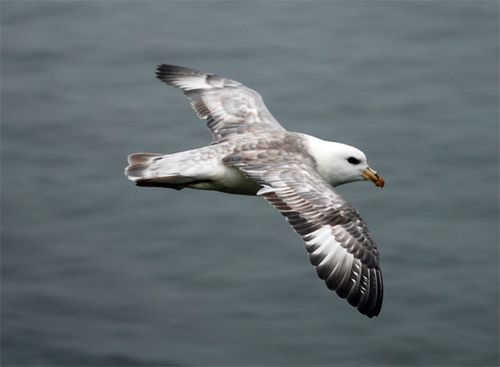My father kindled my interest in birds when I was a boy. He would take my brothers and me up to the local hawk watch site on Hook Mountain in the lower Hudson Valley of New York State. We'd see red-tailed hawks, kestrels and lots of turkey vultures passing overhead on their southward migration. As I got a bit older, I would join him on Christmas Bird Counts, hiking up a mountain path in the pre-dawn darkness, hooting up great horned owls in the pine grove near the top of the hill. My Dad is gone now, but I know that he'd be tickled at the experience that I've had here on St. Paul Island and marvel at the birds that I've had the chance to see. I believe that my interest in birds helped to strengthen my teacher application for this PolarTREC assignment, so in a way, I have my father to thank for helping me to get to this fantastic island of birds.
I have managed to see several "lifers" during my time on this project. These are birds that I've seen for the first time in my lifetime of looking at birds. Additionally, I've gotten to see many other birds up close (have even held some in my hand), that I'd only seen once or twice before coming here. Often that view was a barely discernable dot bobbing on the ocean as I made an identification of a distant seabird through a spotting scope.
As I mentioned in one of early my journal entries, the Pribilofs are known for vagrant birds that stray over from Siberia (as well as some that stray over from mainland Alaska). However, for the most part, this is a springtime phenomenon. Most of the unusual sightings here occur during the month of May when migrant birds are on the move and make a wrong turn at Vladivostok and find themselves out over the Bering Sea. While I wasn't here for prime time, fall migration is getting underway and I have managed to see a couple of lifers on this trip.
My very first life bird of the trip was spotted within minutes of moving in to my house on St. Paul Island. As I looked around outside at the view of the harbor, I noticed a Gray-crowned Rosy Finch perched on top of a neighboring house. I'd expected to see plenty of these birds, but not from my living room window!
 Gray-crowned Rosy Finch at Zapadni Ddip
Gray-crowned Rosy Finch at Zapadni Ddip
Another exciting bird for the list was a Red-necked Stint, a pretty little shorebird that breeds in Eurasia. This one found its way to Antone Slough on St. Paul Island and I was lucky enough to see it. I'd heard about the bird from one of the local bird guides on the island. I missed it on my first attempt, but scored on the second.
 Red-necked Stint at Antone Slough
Red-necked Stint at Antone Slough
A Slaty-backed Gull was also a lifer for me. I took a ride today for the first time, to the northeast part of the island. This dark-backed gull sat cooperatively among the pale Glaucous-winged Gulls and stood out like a sore thumb. Another gull sighted early in the trip the Sabine's Gull was also a life bird. This gull spends much of its time at sea and is rarely seen from shore, except perhaps, after a hurricane makes landfall sweeping the little Sabine's Gull along with it.
Another type of gull that was added to my life list is the Red-legged Kittiwake, a bird that breeds only on four islands in the Bering Sea. While reasonably common birds here, their numbers are declining on St. Paul Island, a definite cause for concern.
 Red-legged Kittiwake shown with Black-legged Kittiwake from the Salt Lagoon
Red-legged Kittiwake shown with Black-legged Kittiwake from the Salt Lagoon
Rock Sandpipers are almost everywhere on the island, but still, it was exciting to see my first one here as a life bird! They are very attractive birds in their adult breeding plumage. As we move on towards the fall, the birds lose their more brilliant coloring and take on their more drab basic coloration and patterning. The juvenile birds start out with very plain markings for their first season of life.
 Juvenile Rock Sandpiper near Tourist Point
Juvenile Rock Sandpiper near Tourist Point
Although not vagrants, many of the seabirds that I've seen on this project were lifers, including the Least, Crested and the Parakeet Auklets. All fantastically interesting birds that were studied at close range. I never tire here of watching the Northern Fulmars soar just above the edge of the cliffs. I'd only seen these birds from whale-watching boats, where the spray, the fog and the distance from the bird make for rather unsatisfying views.
 Least Auklets near Zapadni
Least Auklets near Zapadni
 Northern Fulmar near Tourist Point, Saint Paul Island
Northern Fulmar near Tourist Point, Saint Paul Island
With less than two days remaining in the field portion of my PolarTREC experience there is still a chance that another bird or two will make the list. In any event, this was definitely an opportunity of a lifetime as a birder and as a teacher. As I reflect back on what brought me to this incredible place, two words come to mind, "Thanks Dad!"
Bird Species seen: Red-faced Cormorant, Harlequin Duck, Northern Pintail, Long-tailed Duck, Tufted Puffin, Horned Puffin, Thick-billed Murre, Common Murre, Northern Fulmar, Least Sandpiper, Wandering Tattler, Rock Sandpiper, Red-necked Stint, Ruddy Turnstone, Long-tailed Jaeger, Black-legged Kittiwake, Red-legged Kittiwake, Sabine's Gull, Glaucous-winged Gull, Slaty-backed Gull, "Vega" Herring Gull, Winter Wren, Lapland Longspur, Gray-crowned Rosy Finch. Mammals: Arctic Fox, Northern Fur Seal, Steller Sea Lion, Harbor Seal

